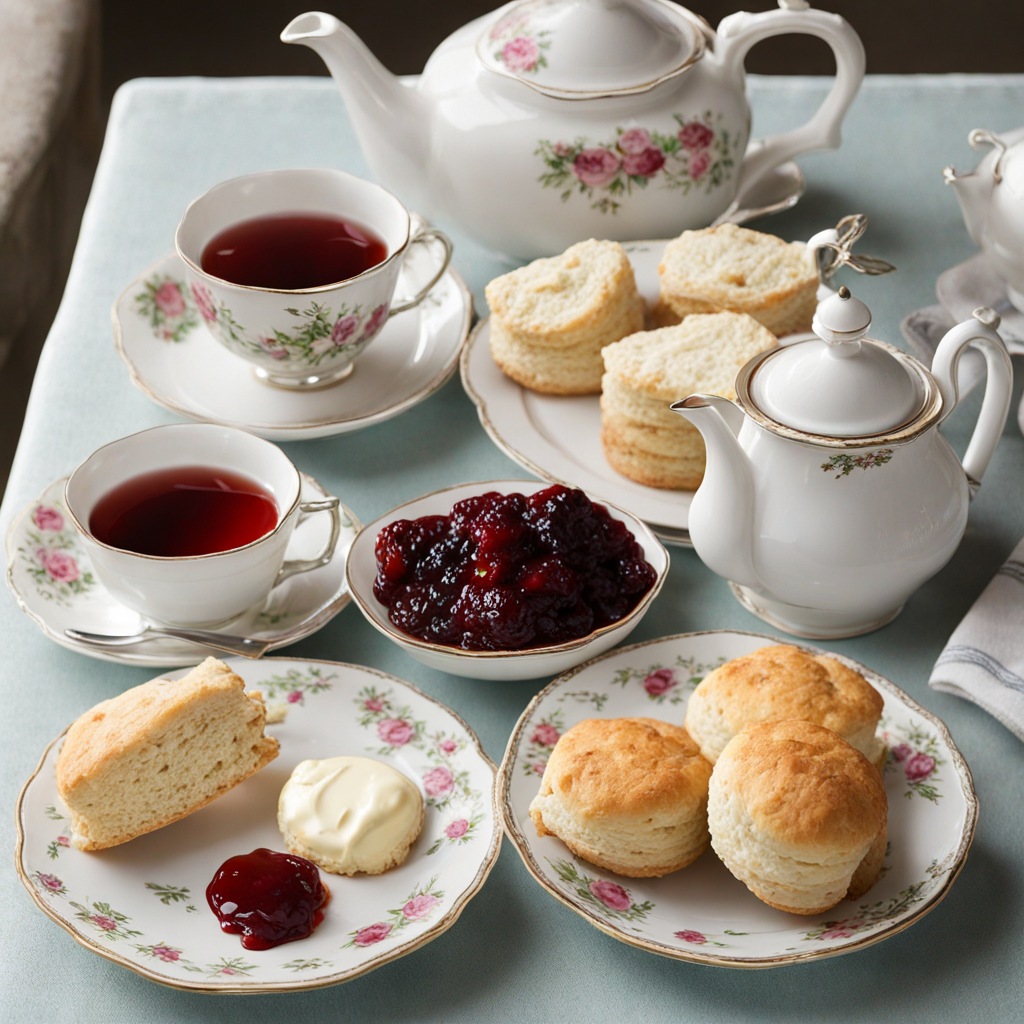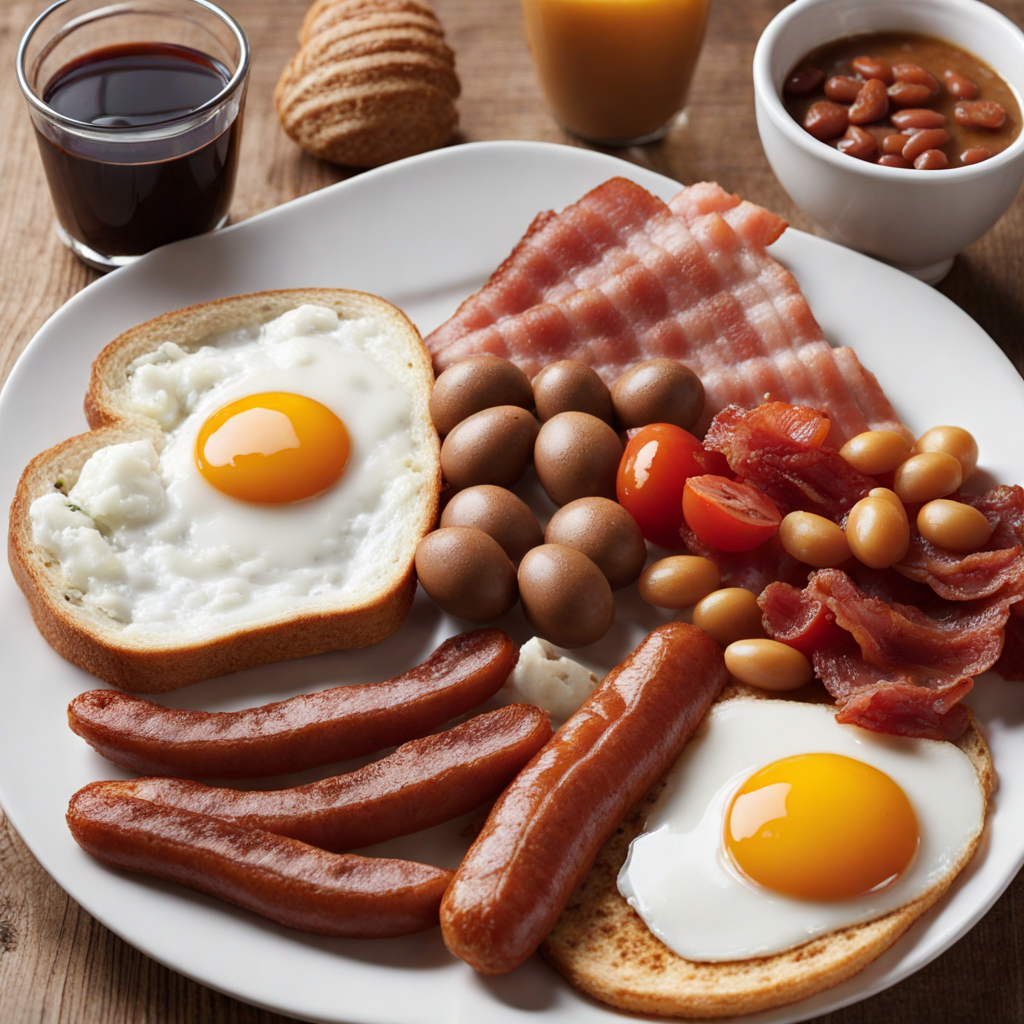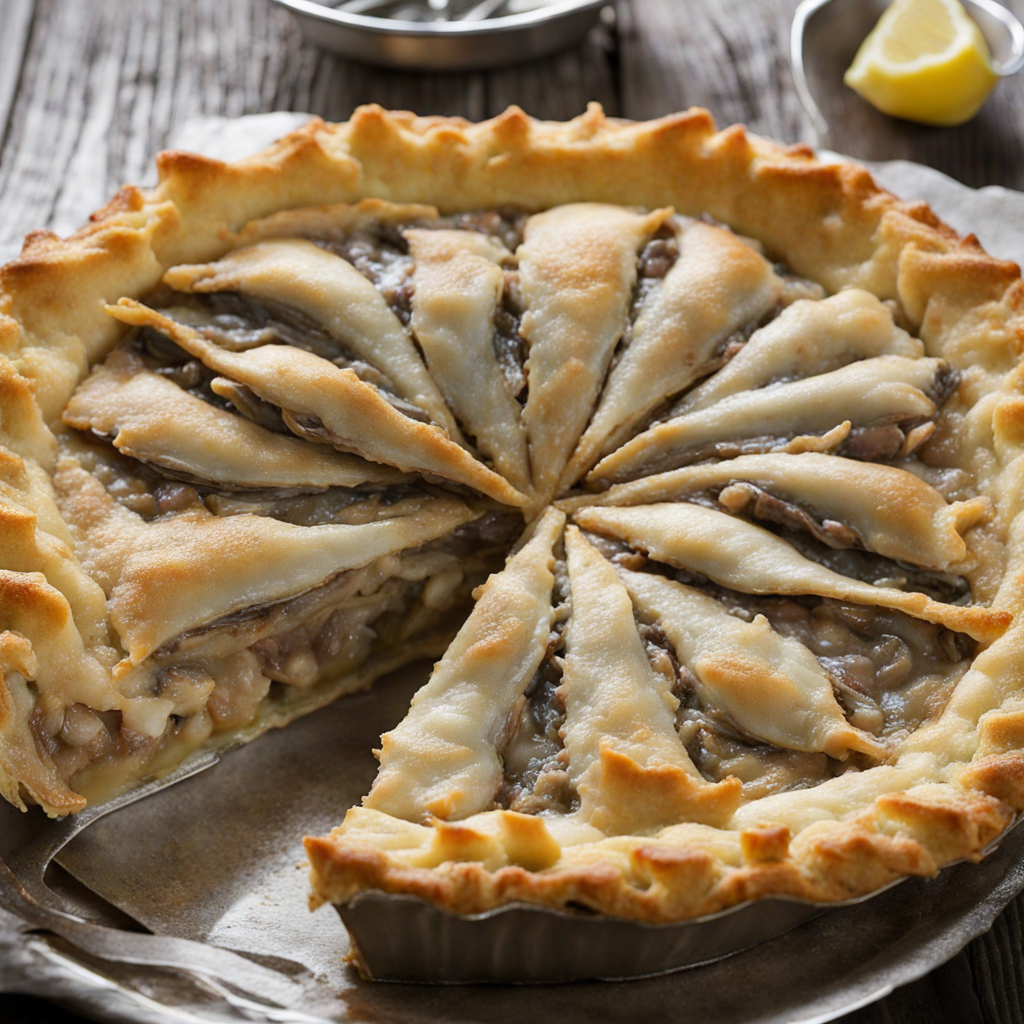Tea and Scones
Tea and scones are a quintessential part of British culinary tradition, celebrated for their comforting flavors and delightful textures. The scones themselves are light, fluffy baked goods, often made with simple ingredients such as flour, butter, sugar, milk, and baking powder. They can be enjoyed plain or enhanced with ingredients like raisins, currants, or even lemon zest, adding a subtle sweetness and a hint of fruitiness. When baked to perfection, scones have a golden crust and a soft, tender crumb that practically melts in the mouth, making them an irresistible treat paired with a warm cup of tea. Accompanying the scones is the ritual of tea, which varies in type and strength depending on personal preference. A classic choice is a robust black tea, such as Earl Grey or English Breakfast, infused with rich flavors that complement the sweetness of the scones beautifully. Traditionally, the tea is served in a teapot, allowing for a leisurely experience as you pour it into fine china cups. The aromatic steam wafts up, inviting you to take a sip and savor the nuanced flavors that enhance the overall enjoyment of the meal. The true magic of tea and scones lies in the delightful accompaniments that elevate the experience. A generous spread of clotted cream—rich and velvety—pairs exquisitely with the warm scones, while a dollop of fruity jam adds a vibrant burst of flavor. The interplay of textures and tastes creates a harmonious balance that is both comforting and indulgent. Whether enjoyed during afternoon tea or as a cozy treat at any time of day, this delightful pairing invites you to slow down, relax, and revel in the simple pleasures of life.
How It Became This Dish
The Engaging History of Tea and Scones in the United Kingdom Origins of Tea in the UK The story of tea in the United Kingdom begins in the early 17th century when the beverage was introduced from China. Initially enjoyed by the aristocracy, tea was a luxury item, imported at great expense. It quickly gained popularity among the wealthy classes, who were drawn to its exotic origins and health benefits. By the late 17th century, tea had become a fashionable drink, with tea houses springing up across London. The East India Company played a significant role in this burgeoning trade, ensuring that tea was accessible to the upper echelons of British society. The Introduction of Scones While tea was finding its place in British culture, the scone was evolving independently. The scone is believed to have originated in Scotland, derived from the word "scone," which refers to a stone that was used to bake flat cakes. The earliest recipes for scones appeared in Scottish cookbooks in the 16th century, where they were made with oats and were often baked over an open fire. These early scones were quite different from the modern versions that we enjoy today. The classic English scone, made with flour, baking powder, butter, milk, and sugar, is thought to have emerged in the 19th century. It was likely influenced by the Scottish scone but underwent refinement with the use of wheat flour, which gave it a lighter texture. The scone became a staple in English baking, particularly as the Victorian era brought about a heightened interest in afternoon tea. The Birth of Afternoon Tea The cultural significance of tea and scones in the UK can be traced back to the mid-19th century with the advent of the tradition of afternoon tea. Anna Maria Russell, the Duchess of Bedford, is credited with popularizing this practice around 1840. The Duchess found that the long gap between lunch and dinner left her feeling hungry, so she began inviting friends to her estate for tea and light refreshments in the afternoon. This social gathering included a variety of snacks, including sandwiches, cakes, and, notably, scones. As the concept of afternoon tea spread, it became a fashionable social event, particularly among the upper classes. The ritual of afternoon tea evolved into an elaborate affair, complete with fine china, table linens, and an assortment of delicacies. Scones, often served warm with clotted cream and jam, became an essential component of this experience, symbolizing the refinement and elegance of the time. Cultural Significance and Social Class The tradition of tea and scones is deeply intertwined with British social structure. Afternoon tea was initially a practice of the aristocracy, but it gradually trickled down to the middle classes. By the late 19th century, tea rooms began to appear in urban areas, making the experience accessible to a broader audience. These establishments catered to those who could not host their own afternoon teas, offering a place to indulge in tea and scones in a social atmosphere. The ritual of afternoon tea became a marker of social class and etiquette. The way one presented tea and scones spoke volumes about their social standing. Elaborate tea sets, beautifully arranged tables, and the proper way to serve scones were all part of the performance. The practice of adding clotted cream and jam to scones became a point of contention, particularly between Devon and Cornwall, where each region claims to have the "correct" method of serving. This friendly rivalry further entrenched the cultural significance of scones in regional identities within the UK. Development Over Time As the 20th century progressed, the popularity of tea and scones continued to flourish. The rise of the British tea industry, alongside the growth of tea brands like Twinings and Yorkshire Tea, ensured that tea remained a staple in British households. During the World Wars, tea was promoted as a morale booster, and despite rationing, it remained an integral part of daily life. The post-war era saw a shift in eating habits, with an increasing emphasis on convenience. While the traditional afternoon tea began to wane in popularity, it experienced a revival in the 21st century as part of a broader interest in artisanal and handcrafted foods. Gourmet tea rooms and cafes began to emerge, offering a modern take on the classic tea and scone experience, often featuring inventive flavors and unique combinations. Modern Interpretations of Tea and Scones Today, tea and scones are celebrated not just as a culinary delight but as cultural icons of British heritage. The ritual of afternoon tea has made a comeback, with hotels and tea houses offering luxurious experiences that hark back to the Victorian era. Here, guests can indulge in a variety of scone flavors, from classic plain and fruit scones to innovative options like chocolate chip or lavender-infused scones. The rise of social media has also transformed how tea and scones are consumed. Aesthetic presentation has become paramount, with scones served alongside artisanal jams and high-quality clotted cream, often photographed and shared online. This trend has contributed to the ongoing popularity of tea and scones, making it a delightful experience that transcends generations. Culinary Legacy and Global Influence Tea and scones have also left an indelible mark on global culinary practices. As British colonization spread tea culture around the world, many countries adopted their own versions of afternoon tea. Countries like India and Sri Lanka, which now produce significant quantities of tea, have incorporated their own traditions and flavors into the ritual. Scones have also found their way into various cuisines, adapted to local tastes and ingredients. In summary, the history of tea and scones in the United Kingdom is a fascinating tale of cultural evolution, social significance, and culinary delight. From their aristocratic origins to their current status as beloved national treasures, tea and scones represent not just a meal but a rich tapestry of British history. As we savor a warm scone with a cup of tea, we partake in a tradition that has been cherished for centuries, bridging past and present in a delightful union of taste and culture.
You may like
Discover local flavors from United Kingdom







